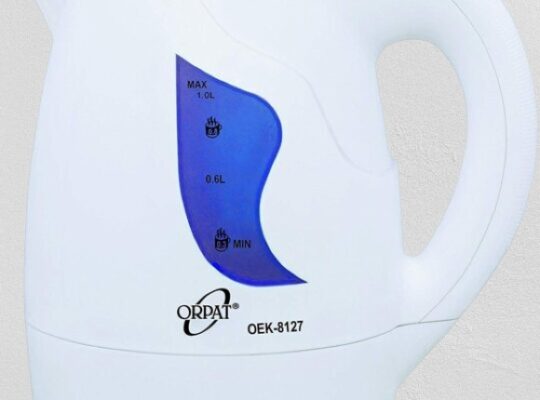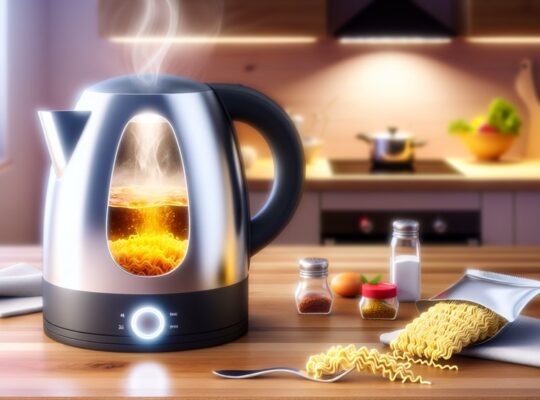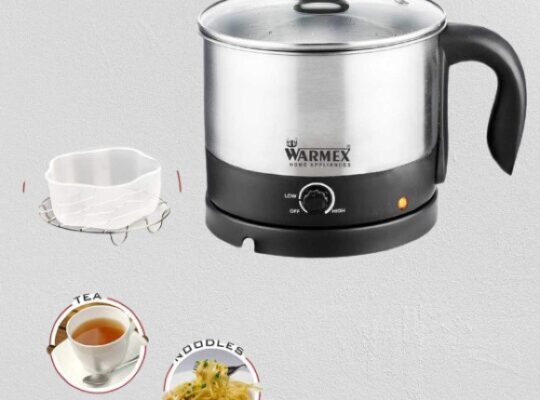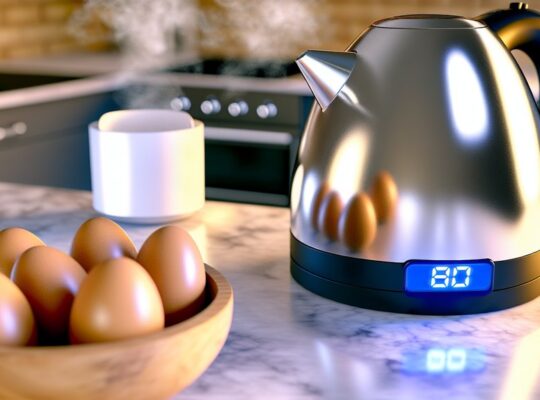Using an electric kettle is simple. First, check the kettle’s type and inspect it for damage. Fill it with the desired amount of water, making sure the lid is securely closed. Set the temperature if your kettle has that feature, and then turn it on. Wait for the water to boil before carefully pouring it. Remember to clean and maintain your kettle for peak performance, and you’ll discover even more tips to enhance your brewing experience.
Key Takeaways
- Ensure you understand your kettle type and read the manufacturer’s manual for specific instructions and features.
- Fill the kettle with the desired amount of water, checking the water level indicator for accuracy.
- Set the temperature according to your beverage needs, using precise adjustments for optimal brewing.
- Monitor the kettle while in use, keeping it on a stable surface and away from flammable materials.
- Clean the kettle regularly, descaling monthly, and store it properly to maintain performance and longevity.
Understanding Your Electric Kettle
Understanding your electric kettle is key to maximizing its efficiency and enjoying your favorite hot beverages. The materials used in your kettle greatly impact its performance. Stainless steel and glass kettles are popular for their durability and aesthetic appeal, while plastic kettles are lightweight and often more affordable. Each material has its own heat retention properties, affecting how quickly your kettle reaches boiling point. For energy efficiency, consider kettles with rapid boiling features or those designed to heat water faster. Look for models with automatic shut-off functions to prevent energy waste. By selecting the right kettle materials and understanding their efficiency, you’ll enhance both your brewing experience and minimize your energy consumption. Additionally, the automatic shut-off feature is essential for ensuring safety and preventing overheating.
Preparing to Use the Kettle
Before you start enjoying a steaming cup of tea or coffee, it’s important to prepare your electric kettle properly. First, check the kettle type you have—whether it’s stainless steel, glass, or plastic—since each has specific care instructions. Always read the manufacturer’s manual to make certain you’re familiar with your kettle’s features. Next, inspect the kettle for any damage or cracks, as this can pose safety risks. Make sure the power cord is in good condition and the plug fits securely into the outlet. Finally, follow safety precautions by placing the kettle on a stable surface away from the edge of counters. Taking these steps guarantees not just peak performance but also your safety while using the kettle. Additionally, it’s crucial to remember the importance of regular maintenance to prevent limescale buildup that can affect the kettle’s efficiency.
Filling the Kettle With Water
Filling your electric kettle with water is a straightforward process that guarantees you have just the right amount for brewing your favorite beverage. First, choose your water source—tap water, filtered water, or bottled water will work. Next, it’s important to measure the water accurately to avoid overfilling or underfilling.
- Check the kettle’s water level indicator for guidance.
- Use a measuring cup if you need a precise amount.
- Tilt the kettle gently to pour water without spilling.
Once you’ve filled the kettle to the desired level, securely close the lid. This confirms efficient heating and helps prevent spills while you’re on the go, making your brewing experience smooth and enjoyable. Additionally, ensuring the kettle has safety features like auto shut off can enhance your overall usage experience and provide peace of mind.
Setting the Temperature
Once you’ve filled your electric kettle with water, setting the temperature is essential for achieving the perfect brew. Many kettles offer temperature precision, allowing you to select the ideal heat for different types of beverages. For instance, green tea typically brews best at around 175°F, while black tea might require closer to 200°F. If you’re preparing coffee, aim for temperatures between 195°F and 205°F for optimal brewing. Use the kettle’s digital display or dial to adjust the heat accurately. Remember, the right temperature not only enhances flavor but also preserves the integrity of the ingredients. By mastering temperature settings, you’ll elevate your beverage experience, ensuring every cup is just how you like it.
Turning the Kettle On
To turn on your electric kettle, first, plug it in securely to a power outlet. Next, select your desired temperature setting based on what you’re brewing. Once you’ve made your selection, the kettle is ready to heat your water efficiently. This process utilizes a heating element that converts electrical energy into thermal energy, allowing for rapid boiling.
Plugging In Safely
Before you turn on your electric kettle, make certain it’s plugged in securely to a suitable power source. This step is essential for avoiding electrical hazards. Here are some safety precautions to follow:
- Check the cord: Verify it’s free of frays or damage.
- Use a grounded outlet: This reduces the risk of electrical shock.
- Keep away from water: Avoid spills around the plug or outlet.
Selecting Temperature Settings
How do you choose the right temperature for your beverage? Most electric kettles come with temperature presets that simplify this process. For example, green tea typically brews best around 175°F, while black tea requires around 200°F. If you’re making coffee, aim for water at about 195°F to 205°F for ideal brewing.
To select the desired temperature, simply press the corresponding preset on your kettle. If your kettle doesn’t have presets, manually adjust the temperature using the dial or buttons, if available. Pay attention to the kettle’s indicator, ensuring it reaches the desired setting before you pour. This way, you’ll enhance the flavor and aroma of your drink, making every sip enjoyable. Additionally, using the kettle for brewing French press coffee can further elevate your morning routine. Happy brewing!
Waiting for the Water to Boil
Waiting for the water to boil can feel like a quick moment in your kitchen routine, but it’s vital to get it right. Knowing the boiling time is important for the perfect brew. Most electric kettles come with a temperature gauge that helps you monitor the process, making sure you achieve the best results.
Here are a few tips to enhance your experience:
- Don’t rush: Allow the kettle to reach the desired temperature without interruptions.
- Keep an eye: Watch the temperature gauge to make sure you’re aware of the progress.
- Choose the right kettle: Quality kettles often have faster boiling times and precise temperature controls.
Pouring the Boiled Water Safely
Pouring boiled water safely is essential to prevent burns and spills. First, make sure the kettle is on a stable surface before you lift it. Use a pot holder or towel if the handle feels hot. When you’re ready to pour, tilt the kettle gently, keeping the spout aimed at your target. This helps control the flow and reduces the risk of splashing. Always pour slowly and steadily to avoid sudden spills. If you’re transferring water into a cup or pot, consider using a funnel for added precision. Finally, keep your hands clear of the spout to minimize the chances of burns. Following these safety tips and pouring techniques will make for a safer experience with your electric kettle.
Cleaning and Maintaining Your Kettle
To keep your electric kettle in top shape, regular cleaning and maintenance are essential. You’ll want to focus on descaling to prevent mineral buildup, clean the exterior for a polished look, and store it properly to avoid damage. These practices will guarantee your kettle remains efficient and lasts longer.
Regular Descaling Practices
While your electric kettle may seem like a simple appliance, regular descaling is essential for maintaining its performance and longevity. To keep your kettle in top shape, follow these descaling frequency guidelines:
- Monthly for hard water areas: If you live in an area with hard water, descale every month to prevent mineral buildup.
- Every 3-6 months for soft water areas: If your water is less mineral-rich, you can descale less frequently.
- Vinegar solution: Mix equal parts of vinegar and water, fill the kettle, boil, and let it sit for an hour before rinsing thoroughly.
Exterior Cleaning Tips
Although your electric kettle is primarily designed for boiling water, keeping its exterior clean is just as important for both aesthetics and hygiene. To maintain its appearance, regularly wipe down the exterior materials, such as stainless steel or plastic, with a soft cloth. For tougher stains, opt for mild cleaning solutions like a mixture of vinegar and water. Avoid abrasive cleaners that could scratch the surface.
Make sure to unplug your kettle before cleaning, and never immerse it in water, especially if it has electrical components. Additionally, check for any accumulated dust or grime around the base and handles. By following these simple tips, you can extend the life of your kettle and keep it looking great.
Proper Storage Techniques
After cleaning the exterior of your electric kettle, proper storage is key to maintaining its performance and longevity. Here are some tips to guarantee your kettle stays in prime shape:
- Store it in a dry, cool place to prevent moisture buildup.
- Use storage containers to protect it from dust and scratches.
- Confirm ideal placement; avoid stacking heavy items on top.
Frequently Asked Questions
Can I Use My Electric Kettle for Cooking Food?
You can use your electric kettle for cooking, but it’s primarily designed for boiling water. For food preparation, consider it for instant noodles, oatmeal, or steaming vegetables, but avoid anything that requires significant cooking time.
Is It Safe to Leave the Kettle Unattended While Boiling?
Leaving your kettle unattended while boiling isn’t safe. Always monitor it closely to prevent accidents. Follow safety tips like keeping it away from flammable materials and ensuring it has proper ventilation for ideal safety.
What Should I Do if My Kettle Doesn’T Turn On?
If your kettle doesn’t turn on, check for power issues first. Confirm it’s plugged in properly and try a different outlet. If it still won’t work, consider kettle troubleshooting or consult the manufacturer for assistance.
How Can I Remove Limescale Buildup From My Kettle?
To tackle limescale buildup, mix equal parts vinegar and water. Pour the vinegar solution into the kettle, let it sit for 30 minutes, then boil and rinse thoroughly. You’ll have a cleaner kettle in no time!
Can I Use My Kettle for Purposes Other Than Boiling Water?
Yes, you can explore alternative applications for your kettle. Beyond boiling water, it’s great for making instant soups, oatmeal, or even steaming vegetables. Just verify it’s safe for those uses to avoid any damage.
Conclusion
Using an electric kettle is quick and straightforward. By understanding its features and following simple steps, you can enjoy perfectly boiled water for your favorite beverages or meals. Always remember to fill the kettle appropriately and handle it safely when pouring. Regular cleaning guarantees your kettle remains in top condition, providing you with efficient performance for years to come. With these tips, you’re all set to make the most of your electric kettle!



